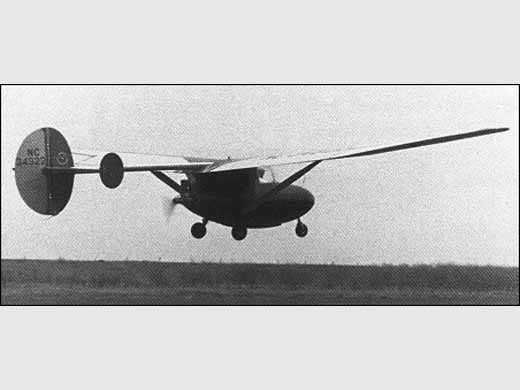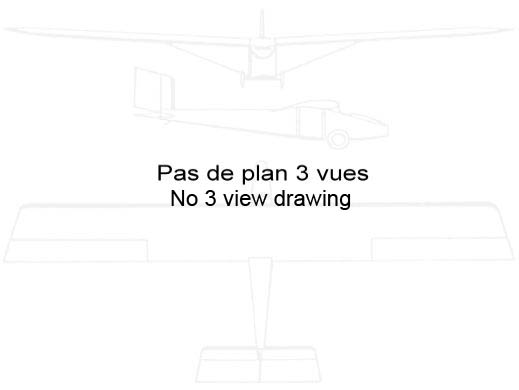| Histoire résumée | The Dragonfly was an early self-launching sailplan whose marketing was sponsored by the Nelson Engine Company as a vehicle for their two- cycle four cylinder engine. The result was an under-powered sailplane. The Dragonfly features a fully retractable tricycle landing gear with stearable nosewheel, dual control and a ratchet- wire pull starter in the cockpit for engine starts in flight or on the ground. Two examples belong to the National Soaring Museum.
In 1945, William H. Bowlus and Ted Nelson formed the Nelson Aircraft Corporation to build a two-seat, motor glider version of the popular Bowlus BA-100 Baby Albatross. The designers nicknamed this design the Bumblebee but they sold the powered glider under the official moniker, Dragonfly. The men retained the basic Baby Albatross design but significantly widened the cockpit and added side-by-side seating and flight controls for each occupant. Other improvements included tricycle landing gear and a steerable nose landing gear, additional vertical fins mounted on the ends of the horizontal stabilizer, and a hinged canopy. A handle to pull-start the engine was also available inside the cockpit. The aft section of the fuselage pod on the Baby Albatross was an ideal place to install a pusher engine and propeller. Bowlus and Nelson first selected a Ryder four-cylinder, two-cycle power plant but this engine only managed to produce about 16 horsepower. This was not enough power for flight so Nelson decided to build a suitable engine from scratch. His new motor generated 25 horsepower, barely enough to takeoff and slowly climb.
This combination of power plant and propeller allowed the Dragonfly to climb 235 feet per minute at sea level. The extra weight of the engine, plus the drag from the widened fuselage, gave the Dragonfly a mediocre lift-to-drag ratio. The self-launch capability cost too much performance to appeal to most prospective motorglider owners and Bowlus and Nelson only sold seven Dragonflys. Nelson attempted to design another self-launching glider in 1949 but this time, he teamed with Harry Perl. Don Mitchell also helped on the new airplane. Nelson and Perl called this new design the Hummingbird (see NASM collection). Nelson mounted a more powerful Nelson engine on a retractable pylon behind a two-seat, tandem cockpit. This arrangement improved the soaring performance but the aircraft cost much more than a conventional, two-seat glider and Nelson and Perl built only six Hummingbirds.
The Dragonfly, designed by Hawley Bowlus, was the first auxiliary-powered glider to be produced in the U.S.A. The designers nicknamed this design the Bumblebee but they sold the powered glider under the official moniker, Dragonfly. It featured 2-place, side-by-side seating, retractable tricycle landing gear and a Nelson engine.
While the concept was good, the airplane never achieved real success, because it didn't perform well, and because Nelson took his engine and left the partnership. The beautiful wooden fuselage pod made up of layers of mahogany was very labour intensive and thus very expensive. Some Dragonflys had the engine removed, converting them to pure sailplanes.
Once owned by Peter Bowers, well known designer, historian and glider enthusiast, the Museum’s aircraft was sold to Airplane Supply Centre in 1956, by which time its engine had been removed and it had been converted to a sailplane. It was later sold to Val Hinch of Victoria, who carried out necessary work to license the aircraft and who flew it on Vancouver Island in the early 1960's. It was then placed in storage, and finally donated to CMF in 1983 by Val Hinch. It is one of less than 10 built and of 2 left in the world.
The Dragonfly was the first auxiliary-powered glider to be produced in the U.S. A development of the Baby Albatross in 1945, the first version was called the Bumblebee. It featured 2-place, side-by-side seating, retractable tricycle landing gear and a Nelson engine.
While the concept was good, the airplane never achieved real success, partly because it didn't perform well, partly because Nelson took his engine and left the partnership, and partly because the beautiful wooden fuselage pod, made up of layers of mahogany was very labour intensive and thus very expensive.
Some of them have had the engine removed, converting them to pure sailplanes.
|
| Exemplaires existants |  | Immatriculé : CF-VFA (En exposition), localisation : CMF - Canadian Museum of Flight, Langley (Vancouver, Canada) |  | Immatriculé : N3?923 (En exposition), localisation : Steven F. Udvar-Hazy Center, Dulles, Virginia (USA) ? |  | Immatriculé : N4ND (Inconnu), localisation : National Soaring Museum, Elmira, Washington D.C. (USA) |  | Immatriculé : xxxx (En stockage), localisation : Smithsonian National Air & Space Museum |
|




